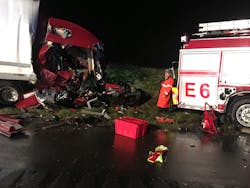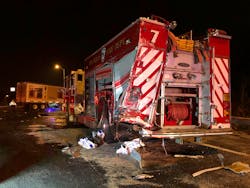There are two types of firefighter line-of-duty deaths and injuries: medical and traumatic. On the medical side, cancer continues to be the number one killer of firefighters. On the trauma side, our greatest chance to get injured or killed is on the roadways, specifically, being struck by passing motorists.
We dedicate this column to Hanover County, VA, Fire-EMS Lt. Brad Clark, who gave his life in the line of duty as described below. By all accounts, Lt. Clark's immediate actions, by alerting his crew, saved their lives.
Dangerous driving
While there are numerous causes, for the past decade, distracted driving has taken North American roadways by storm, endangering not only the distracted drivers themselves, but also their passengers, those in other vehicles, pedestrians—and firefighters. In fact, one out of every four crashes involved distracted drivers. Over the last few years, an average of 3,500 people were killed and 400,000 people were injured each year due to distracted driving crashes.
As I am writing this column, the International Association of Fire Chiefs (IAFC), in cooperation with The Responder Safety Institute and major fire service organizations, issued a FIRE & EMS Survival Alert specifically focused on awareness, training and best practices to minimize firefighters being struck on roadways.
I reached out to two departments to share their recent events so that we can all learn and further understand the dangers of operating on roadways. My sincere thanks to Hanover County, VA, Fire-EMS, Assistant Chief Eddie Buchanan and Dix Hills, NY, Fire Department Assistant Chief Brett Tepe, along with their chiefs, officers and members, for sharing these stories so that we all can learn. Readers, please understand that due to the timeliness of this column, some of the details of these incidents, including specific findings and lessons learned cannot yet be shared due to pending legal action.
Hanover County, VA
Hanover County Fire-EMS has 16 stations, with 200 career members and 323 volunteers running approximately 30,000 responses annually.
On Oct. 11, 2018, Tropical Storm Michael was pounding the East Coast. Hanover County Fire-EMS units were responding to high call volumes across the county. At 9 p.m., Engine 6 was dispatched to Interstate 295, southbound at the 38-mile marker, for a vehicle crash. Engine 6 was staffed by Lt. Brad Clark, Driver/Firefighter David Johnson, Firefighter Chris Elish riding in the jumpseat behind the officer, and Probationary Firefighter Carter Lewis, who was riding behind the driver.
It should be noted that Lewis was scheduled to graduate from the Hanover Fire-EMS Fire Academy that night, but the ceremony was postponed due to the storm. All graduates were sent to their assigned stations to assist with the storm response. This was Lewis’ first official tour.
Engine 6 arrived on scene with a vehicle in the median. They positioned their unit to block their work zone and were stepping off the rig to assess the scene. As Clark was walking around the front to the apparatus cab, he saw a tractor-trailer coming straight for the unit, and he yelled to his crew to alert them. Elish heard Clark’s warning and dove headfirst back into the jumpseat, where he had been reaching for the medical bag.
The tractor-trailer struck Engine 6 in the rear, knocking the pumper forward overtop of Clark, pinning him under the unit. The engine also struck Johnson, causing life-threatening injuries. Lewis was also struck, causing traumatic injuries to his leg that ultimately resulted in amputation below the knee.
The crash was witnessed by arriving crews who began to treat the injured firefighters on arrival. Additionally, Elish climbed from the mangled engine and began to treat his crewmembers. Elish later drove the ambulance that carried one of his brothers to the hospital.
Arriving crews had two red condition firefighters needing immediate treatment; the tractor-trailer driver entrapped in the vehicle but in yellow condition so his treatment could be delayed; one gray condition lieutenant, meaning his injuries were incompatible with survival; and one patient in the original vehicle at the accident scene. Clark was ultimately pronounced dead at the scene.
Dix Hills, NY
The Dix Hills Fire Department is a bedroom community in the suburbs of Long Island, covering 26 square miles of mainly residential neighborhoods. Dix Hills has 200 volunteer fire and EMS members responding from three fire stations located throughout the district. In 2018, the Dix Hills Fire Department responded to almost 3,000 fire and EMS alarms.
On Nov. 19, 2018, Heavy Rescue Engine 2-8-7 was set up as the blocking engine of a safety zone for a crash on the Long Island Expressway. The crew helped package one patient for transport and clean the roadway for approximately 10 minutes on scene. The crew then secured their truck and were seated inside waiting for the ambulance to depart for the hospital.
At that moment, a tractor-trailer being driven eastbound on the Expressway drifted over and made contact with the rear driver’s side of 2-8-7. The tractor-trailer then jackknifed and came back into the safety zone area, striking the back of the highway patrol car on scene with one officer seated inside.
The officer of 2-8-7 checked on his crew; no one was injured. The officer then checked on the highway patrol officer, who was injured but stable, and then they immediately went into heavy rescue operations to free the trapped driver of the tractor-trailer who was initially unconscious. He removed the driver’s door and prepared the driver for transport.
When conscious and questioned about what had happened, the truck driver responded, “I remember seeing flashing lights up ahead and that’s the last thing I remember.”
For their actions, 2-8-7’s crew was given a Truck Company Unit Citation by the Dix Hills Fire Department.
Key takeaways
Operating on any roadway—and especially high-speed roadways—is without question the greatest risk you have as a firefighter and/or EMT. In my opinion, the road should be safely shut down, in coordination with law enforcement, as soon as possible to minimize the risk to our members. Quite frankly, when traffic is at a standstill, we minimize the risk of traffic speeding by but, unfortunately, it's not a simple task.
In the two crashes featured this month, there was little to nothing that could have been done differently to avoid these incidents. The members responded, blocked and attempted to help people. In Hanover, they were doing exactly as expected, as was the case in Dix Hills, and even then, tragedy struck. However, it is the obligation of every fire officer to ensure that the best practices and standards are followed, per your department’s policy (in coordination with law enforcement).
We must operate on the roadways as if all drivers are distracted and absolutely no one sees us. Now is the time to train, drill and plan to best honor those who have given their lives on roadways while trying to help others.
Please visit the Emergency Responder Safety Institute at ResponderSafety.com for professional resources, including free training for all of your personnel related to roadway survival. Take their free, online training, and learn how to safely and properly shut down a roadway so you are prepared. The website is operated by subject-matter experts with decades of service as firefighters who have your back and who want you to understand the best ways to operate on roadways.
Sidebar: IAFC Issues Safety & Survival Roadway Operations Alert
The IAFC, through its Safety, Health and Survival Section and in cooperation with the Emergency Responder Safety Institute, are urging all fire chiefs and officers to immediately issue a safety and survival alert in their departments.
During an emergency safety and survival alert, personnel are urged to postpone non-emergency tasks to focus on critical safety and survival training. The period is also used to remember the many firefighters whose lives have been lost working on roadways due to incidents of personnel and apparatus being struck.
In addition to department polices and federal, state and local laws, other resources are available to use during this alert and in ongoing efforts to educate personnel about safe roadway operations.
The Emergency Responder Safety Institute offers a single portal with an online network for training, with the goal of protecting our responders on the roadway. Additionally, Respondersafety.com hosts the ResponderSafety Learning Network (rsln.org). These sites offer a variety of resources to aid in training firefighters to be prepared for the dangers associated with roadway responses, including online modules and certificates for completion. The ResponderSafety Learning Network also delivers the Federal Highway Administration National Traffic Incident Management Certificate.
The Federal Highway Administration has developed Traffic Incident Management (TIM), which includes a variety of best practices and resources and a Traffic Incident Management Handbook. It offers the National Traffic Incident Management Responder Training Program that incorporates both online and in-person training.
NFPA 1500: Standard on Fire Department Occupational Safety, Health, and Wellness Program (2018) includes an updated Chapter 9 dedicated to Traffic Incident Management that requires training related to roadway-incident safety. NFPA 1091: Standard for Traffic Control Incident Management Personnel Professional Qualifications identifies the minimum job performance requirements (JPRs) for TIM personnel.
The IAFC's Near Miss Program (firefighternearmiss.com) collects and shares firefighter near-miss experiences, allowing others to learn from these experiences. There are several available about personnel and apparatus struck while operating on roadways, sharing valuable information about how these incidents occurred and how they can be avoided in the future.
Together, these suggested materials and sites form a useful toolkit to use in conjunction with the safety alert as well as your continued department training and education efforts.
The IAFC Safety, Health and Survival (SHS) Section provides guidance and resources toward a clear mission—to reduce the number of preventable line-of-duty deaths and injuries in the fire and emergency service.
The Emergency Responder Safety Institute is funded in part by the FEMA Assistance to Firefighters Grant Program, the U.S. Fire Administration and the U.S. Department of Justice. Highway Near Misses may be reported to ResponderSafety.com thanks to an agreement with the IAFC.
About the Author
Billy Goldfeder
BILLY GOLDFEDER, EFO, who is a Firehouse contributing editor, has been a firefighter since 1973 and a chief officer since 1982. He is deputy fire chief of the Loveland-Symmes Fire Department in Ohio, which is an ISO Class 1, CPSE and CAAS-accredited department. Goldfeder has served on numerous NFPA and International Association of Fire Chiefs (IAFC) committees. He is on the board of directors of the IAFC Safety, Health and Survival Section and the National Fallen Firefighters Foundation.


